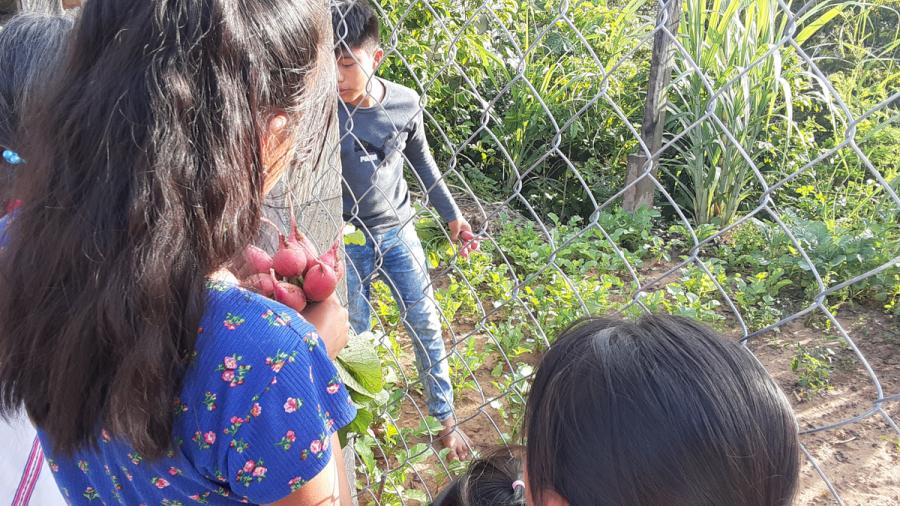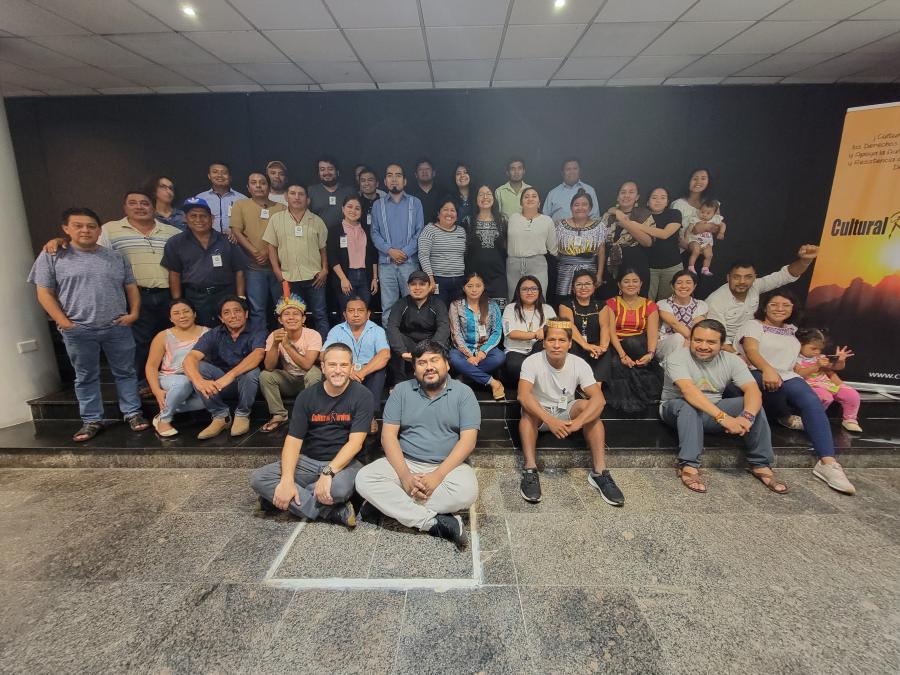Chan K'in Viejo, an elder of the Lacandón Indians of Chiapas, Mexico, shared tales of life in the Selva Lacandona and legends from the Lacandón-Maya cultural tradition. From the writings of Jacques Soustelle, Frans and Trudy Blom, Robert Bruce, Victor Perera, Linda Schele, and others, Chan K'in was known as an amicable and wise man with an extensive knowledge of Lacandón lore and legends.
As the loss of the rainforest brought the Lacandóns into greater contact with foreign influences, Chan K'in encouraged his people to value and preserve their own unique culture. The Lacandón village of Nahá, where Chan K'in lived until his death on December 23, 1996, remains the most traditional of all Lacandón communities. However, how the Lacandón adapt to change has become increasingly important to the people of Nahá. The balance between change and maintaining traditional practices was under the stewardship of Chan K'in; others must now fill this role if their traditions are to survive.
The Importance of Tradition
Much of the Lacandón mythology parallels the archaeological records of Palenque, Yaxchilán, and Toniná. At these sites, events and deeds of the ancient Maya were recorded in hieroglyphs before they passed into memory and finally, into myth. These myths were preserved by generations of Maya descendants (the ancestors of the Lacandóns) before Chan K'in's father learned the tales from his father. According to Chan K'in, to dismiss the gods denies the identity and culture of the Lacandón people and censures their history. Lacandón reverence for their gods has enabled the Lacandón of Nahá to maintain this identity.
The Christian Era
For the most part, the Lacandóns avoided the brunt of the conquest by dispersing throughout the jungle. There, they remained relatively free from outside influences until the mid-1940s when landhungry peasants and government policy began forcing the Lacandóns into three restricted areas. Finally given legal rights (now unenforced) to their remaining lands in the 1970s, the Lacandón population clustered into villages to avoid the invading campesinos, or `peasants.' The problem of proselytizing among a dispersed population was thus eliminated.
Many people of Nahá claim that the Seventh Day Adventist missionaries working at the neighboring Lacandón village of Metzaboc would deny medical aid to those Lacandóns who refused to convert. Lacandón converts from this community are often blamed for the destruction of many sacred sites in the jungle-mostly ancient cave burials full of artifacts, rock paintings, and human skeletons. These archaeological sites were destroyed (allegedly, with tacit missionary approval) because they were deemed sacred by those Lacandóns who clung to traditional beliefs.
Inevitable Change
Chan K'in's conservative influence bolstered self-esteem and fostered a sense of identity which limited the efficacy of Christian missions to Nahá. Nevertheless, ritual traditions have suffered the repercussions of inevitable material changes. For example, the availability of modern medicines has contributed to a decline in ceremonies for curing illnesses and insuring health.
A road reached Nahá in 1980 and electricity followed in 1990. Now, televisions acquired through the tourist trade make information readily accessible. After a program explaining our solar system, one of Chan K'in's sons said that his father's old stories lie when they teach that the sun passes each night through the Underworld-a realm conceptually unchanged from that of the ancient Maya.
Furthermore, the Lacandóns are increasingly occupied with a different kind of survival which depends more on selling their crafts than successful hunts. While much of the wildlife is pushed toward extinction in a forest that is further reduced each year by invading campesinos, rituals for good hunting and other rites based on a rain forest economy are becoming increasingly meaningless.
However, another of Chan K'in's sons, T'oh, managed to affirm his father's teachings in the eyes of the Lacandón people. During the 1998 drought, T'oh twice prayed for rain in day-long ceremonies, carefully following his deceased father's methods. The first ceremony brought rain that fell so heavily, it extinguished the fires sweeping through the unusually dry forest. The second ceremony brought another heavy rain that began later the same day and lasted all night, providing desperately needed water to the crops.
The Lacandóns weigh these kinds of tenuous confirmations against apparent contradictions, sometimes confirming and sometimes questioning old beliefs or new ideas. Medicine, roads, and education are vital for survival in a modern world, but they are also powerful vehicles of change.
Sacred Rites. Sacred Sites
Tourism now offers the Lacandón culture an economic scaffold which supports at least a façade of tradition. Aware of the way they are still perceived and portrayed, many have become `professional savages.' Occasionally, even a traditional ceremony is initiated at a filmmaker's paid request. Tourists and filmmakers are important to the Nahá economy and they redirect, if only momentarily, young Lacandóns' attention to their own cultural heritage.
Keeping Lacandón culture intact is a constant struggle. When rites and rituals are performed in the absence of outsiders, they are indicators of a viable faith. Of the six traditional, thatched-roofed temples used for religious activities at Nahá, two have fallen into disuse since Chan K'in's death. Ceremonies continue, however, in the remaining four temples and in remote jungle sites far from tourists and filmmakers. Many sacred sites lie on lands now allocated by the government to farming and ranching settlements. Nevertheless, when Lacandóns trek near the ruined homes of gods, some will stop to make offerings among temple stones now scattered by looters.
Today, rituals are not performed as often and fewer people participate. Lacandóns 18 years old and younger comprise the first generation to have never known a time without roads or televisions.
A Pagan Saint
The Lacandón culture, vacillating between ancient customs and modern Mexico, was challenged immediately after Chan K'in's death. His traditional burial was interrupted by a Baptist minister who chimed to have filmed Chan K'in's conversion to Christianity shortly before his death. The pastor shook a VHS cassette toward the Lacandóns offering it as proof that "Hachäkyuum [a Lacandón god] is worthless." He implored the Lacandóns to accept Christ into their hearts and avoid the fires of hell. Undaunted, the Lacandóns ignored the ministers tearful pleas for Christ and his prayers for Chan K'in; they continued with their own traditional burial rites. In a rare show of unity, they reaffirmed their common culture and expressed their respect for Chan K'in.
Chan K'in's two surviving widows denied his conversion. The video, most people of Nahá agree, is meaningless if it exists at all.
Chan K'in's Legacy
With Chan K'in's death, echoes from an ancient culture are fading as they have done perhaps with each succeeding generation. Chan K'in's father (an informant of Alfred Tozzer more than 90 years ago) was a holy man, a T'ohil. Although Chan K'in was revered among his people, he always deferred to his father as the last T'ohil among the Lacandón.
Respect for Chan K'in forestalled evangelism long enough for his people to assess the loss of traditional values in those communities which succumbed. The Lacandóns realize that abandoning their beliefs and oral traditions will sever their cultural ties to a magnificent past. Chan K'in's stories are not lost, they are scattered among his descendants. Chan K'in's first son, also called Chan K'in, has assumed responsibility for his father's traditional temple, however, he is not fond of cameras or questions. He prefers to perform his ceremonies quietly in his father's temple. He says that he will teach his own son if his son wants to learn. The survival of the Lacandón culture ultimately depends upon its perceived worth to the Lacandón youth.
Chan K'in's traditions preserve Lacandón history and foster ethnic identity They teach religion and ritual for spirituality and tribal cohesion. Today, no one person exercises the same influence as Chan K'in, however, several Lacandóns continue to perform ceremonies and to teach younger Lacandóns ritual procedures and oral traditions. The Lacandóns believe they are heirs to a legacy which promises they will not become lost among the millions of rural campesinos in Mexico. It is a legacy they now struggle to protect.
Further Reading
Bruce, Robert D. 1979. Lacandón Dream Symbolism. Mexico, D.F.: Ediciones EuroAmericanas Klaus Thiele.
De Vos, Jan. 1990. Nos queremos ser Cristianos. Mexico, D.F.: Insituto Nacional Indigenista.
Freidel, David, Linda Schele, and Joy Parker. 1993. Maya Cosmos: Three Thousand Years on the Shaman's Path. New York: William Morrow and Company, Inc.
Marion, Maria-Odile. 1990. Lacanja Chansayab: Nuevas Estratagias Frente al Cambio Social. Documento 037-vT/90. San Cristóbal, Chiapas: INAREMAC.
McGee, R. Jon. 1990. Life, Ritual, and Religion Among the Lacandón Maya. Belmont, CA: Wadsworth Publishing
Tozzer, Alfred M. 1907. A Comparative Study of the Mayas and the Lacandóns. New York: Macmillan.
Article copyright Cultural Survival, Inc.



